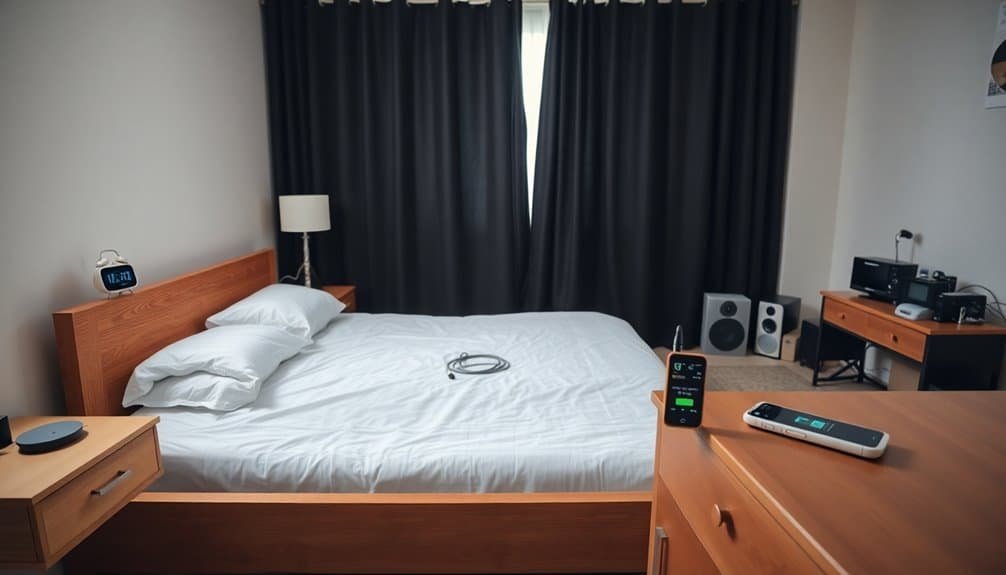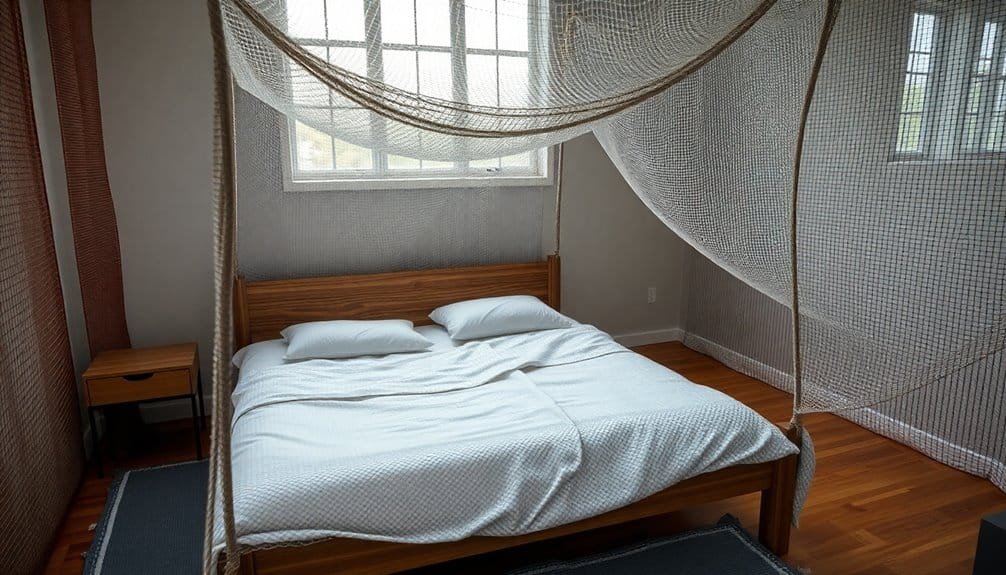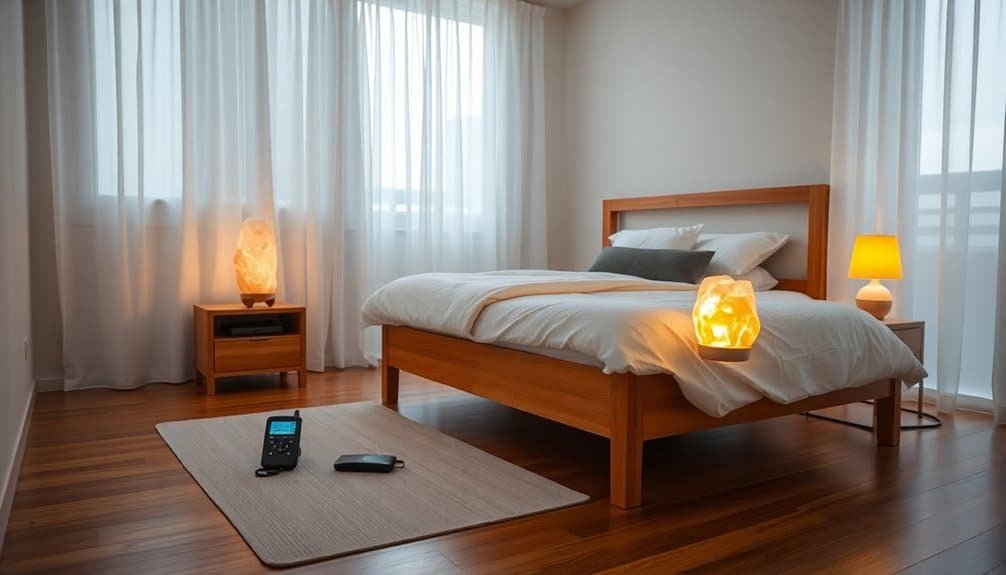Setting Up an EMF-Safe Sleeping Area
To create an EMF-safe sleeping area, remove unnecessary electronic devices and replace wireless gadgets with wired alternatives. Ensure major appliances and electrical wiring are at least 6 to 8 feet away from your bed.
Consider using EMF shielding materials like Y-Shield paint or stainless steel mesh, and opt for low-EMF mattresses. Use an EMF meter to maintain electric and radiofrequency levels below 10 volts per meter.
Disclaimer: As an affiliate, I may collect a share of sales from the links on this page.
Common Sources of EMFs in Bedrooms

Electromagnetic fields (EMFs) can be generated by a variety of sources found in bedrooms. Common appliances, like televisions and computers, emit electric fields when in use. Kitchen appliances, such as microwaves, can also contribute if they’re close to your sleeping area. Electrical wiring inside walls produces electric fields, increasing exposure. Electric fields arise from electrical wiring carrying electric currents and extend 6 to 8 feet from wires, affecting nearby individuals. Portable heaters and air conditioning units are additional EMF sources. Wireless devices, including cell phones and smart watches, emit RF radiation, especially when charging near your bed. Additionally, ungrounded power cords and metal coil mattresses can amplify these fields, resulting in greater exposure during your sleep. To minimize these risks, it is important to identify main EMF sources and implement shielding options to create a safer sleeping environment.
Steps to Reduce EMFs in Bedrooms
To create a sleep environment with reduced EMF exposure, start by removing unnecessary electronic devices from your bedroom.
Next, replace wireless devices with wired alternatives, such as using a wired alarm clock instead of your smartphone. If you must keep devices, distance them from your bed. Moving electric clocks and appliances away from bed can greatly reduce direct exposure to electromagnetic fields. Additionally, consider investing in EMF shielding devices that can enhance your protection against radiation while you sleep.
Consider grounding techniques to neutralize electric fields, like connecting your bed frame to the earth.
Use natural heating methods, such as organic cotton bedding instead of electric blankets.
Finally, turn off all devices nightly to limit EMF exposure during sleep.
Regularly check EMF levels to ascertain your sleeping area remains safe and low in emissions.
Shielding and Protection Measures

Creating an EMF-safe sleeping area involves implementing various shielding and protection measures to mitigate exposure.
Use stainless steel mesh for walls and floors before plastering. Apply Y-Shield paint or use Copper Taffeta fabric for bed canopies. Install window films to block incoming radiation. Electric fields can arise from voltage in the electrical systems within your home, making effective shielding even more crucial. Utilizing EMF shielding paint outdoors can also enhance the overall protection of your sleeping environment.
Opt for breathable materials instead of aluminum foil. Grounding plates and copper straps are essential for effective shielding; connect these to the earth for safety.
Incorporate shielded bed canopies and non-metallic bed frames to minimize EMFs. Finally, select low-EMF mattresses and furniture fabric to enhance your sleep quality in this EMF-protected environment.
Health Implications of EMFs
Understanding the health implications of EMF exposure is crucial, especially given its potential effects on sleep quality.
Research shows that EMF exposure can disrupt your sleep in various ways:
- Sleep Cycle Disruption: EMFs can interfere with your natural sleep cycles, leading to poor sleep quality.
- Sleep Disorders: Extremely low-frequency EMFs are linked to decreased total sleep time and efficiency.
- REM Sleep Impact: ELF EMFs may delay REM sleep and increase time spent in lighter sleep stages.
- Mental Health Risks: Long-term exposure correlates with stress, anxiety, and potential cognitive dysfunction, affecting overall health.
Measuring EMF Levels

Accurate measurement of electromagnetic fields (EMFs) is essential for creating a safe sleeping environment. Use EMF meters to measure electric and radiofrequency fields in your bedroom. Consumer-grade meters are affordable and designed for personal use.
Sweep the meter slowly over key areas, like above your pillow and near electrical outlets, to obtain accurate readings. Test at different times of the day for consistent results. Aim for electric field readings below 10 volts per meter (V/m) for a safer space.
Disconnect appliances and employ shielding solutions to minimize EMF exposure when necessary, ensuring a restful and healthier sleeping area.
Frequently Asked Questions
Can EMFS Affect Pets in the Bedroom?
Yes, EMFs can affect pets in the bedroom. They may experience fatigue, anxiety, or sleep disturbances. Since pets are more sensitive, it’s crucial to evaluate their exposure and create a safer environment for them.
What Are the Signs of EMF Sensitivity?
Oh sure, your headaches, dizziness, and skin rashes are definitely caused by invisible waves from your Wi-Fi. You might experience tingling, nausea, or even heart palpitations. It’s just typical — isn’t it? Enjoy the drama!
How Do I Know if My Mattress Is Emf-Free?
To know if your mattress is EMF-free, check materials—avoid metal components. Use an EMF detector app or hire a professional to assess your mattress’s emissions. Research products and read reviews for EMF-safe options.
Are There Specific Plants That Can Reduce EMFS?
Did you know spider plants can reduce indoor radiation by up to 90%? Incorporating cacti, snake plants, and sunflowers into your space helps absorb EMFs while also purifying the air, creating a healthier environment for you.
How Often Should I Test My Bedroom for EMFS?
You should test your bedroom for EMFs regularly, especially after any changes in your environment. Consider seasonal variations and device updates, and calibrate your EMF meter periodically for accurate readings and safety compliance.
Conclusion
Setting up an EMF-safe sleeping area is crucial for stable sleep. Minimize technology and magnetic fields to reduce exposure.
Use shielding solutions, like protective fabrics or grounded materials, to enhance your environment. Measuring EMF levels provides insights into invisible influences.
Prioritize prevention to safeguard sleep quality and promote wellness. These steps create a peaceful and protected space for rejuvenation and relaxation.

